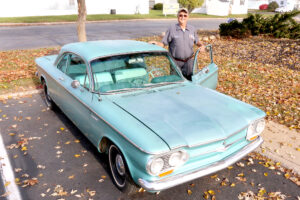By David Fleet
Editor
Brandon Twp.- By today’s standards, Ray Dubia’s ride to work is minuscule compared to the behemoths the cruise America roads today. But what the  Chevrolet Corvair lacks in size it makes up for in uniqueness and automobile history.
Chevrolet Corvair lacks in size it makes up for in uniqueness and automobile history.
Dubia, is the owner of 1961 Model 700 Corviar he purchased from California about five years ago with about 40,000 miles on the odometer.
“There’s no salt on the roads, so the rust was not a problem with the 60 year old car,” said Dubia. “However, the sun really baked the interior so, that had to be replaced when it was restored.”
The Corvair was very basic—powered by an 80 horsepower, 145 cubic inch six cylinder, two carburetor air cooled engine, and a two speed Powerglide automatic transmission. The four tube AM radio still kicks out tunes.
“The rear engine/trans-axle provides great traction until you get about 8 inches of snow,” he said. “Then it the bottom of the car drags you down. Still I drive it everyday and it draws plenty of looks from others.”
Costing about $2,000 new in the early 1960s, General Motors Corvair design took aim at the economy Ford Falcon, VW and Plymouth Valiant cars. To save on weight, in 1960 GM moved toward all aluminum heads and blocks, but added steel sleeves in the cylinders. With the rear engine design the front of the car is know as a “frunk,” a much needed space due to the smaller interior.
“Actually, the backseat folds forward and creates some decent room,” he said. “I’ve driven to Sault Ste. Marie and Texas with no problems cruising at 70 mph—I’ve even had the car up to 100 mph with no issues.”
Still, safety concern of the Corvair ultimately legal fallout lead to its demise and in 1969, just a decade after production started it ended. From beginning the car was scrutinized by political activist Ralph Nader. The first chapter of his 1965 book, “Unsafe at Any Speed,” focused on the Corvair’s rear suspension design, a swing-axle concept similar to the VW Beetle. Nader reported, the design could tuck the outside rear tire under hard cornering, causing the car to roll. Dubia said the13-inch-by-5 inch wide tires require 31 pounds of pressure in the rear tires and 21 inch in the back.
“The tire pressure was key in the issues with the Corvair,” he said. “I’ve never had any problems with the four Corvairs I’ve owned. It’s a great car and a big piece of history.”
